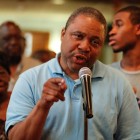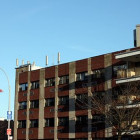On a warm Saturday morning a few weeks ago, a group of older tenants at the River Park Towers in Morris Heights, a neighborhood in the South Bronx, set up a plastic table across from their building. A handful of women stacked small, store-bought cakes wrapped in plastic on top of it and sat down to wait for customers.Someone wheeled in a PA system and a steady stream of 90s hip-hop tunes began to draw neighbors out of their apartments. Soon, a crowd of tenants and their children were sitting outside, enjoying the sunshine and talking about the conditions of the place where they live.”This is about taking back our building, ya’ll,” one woman shouted into the microphone. The story of New York City is often understood as a neat movement from peak to gutter and back up again. The city suffered in the seventies, muddled through the eighties, endured crisis in the early nineties and, at least until the recent recession, has enjoyed a steady ascent colored by declining crime and increasing real estate investments.The problems the city has, meanwhile, are discussed and dissected in isolation.







